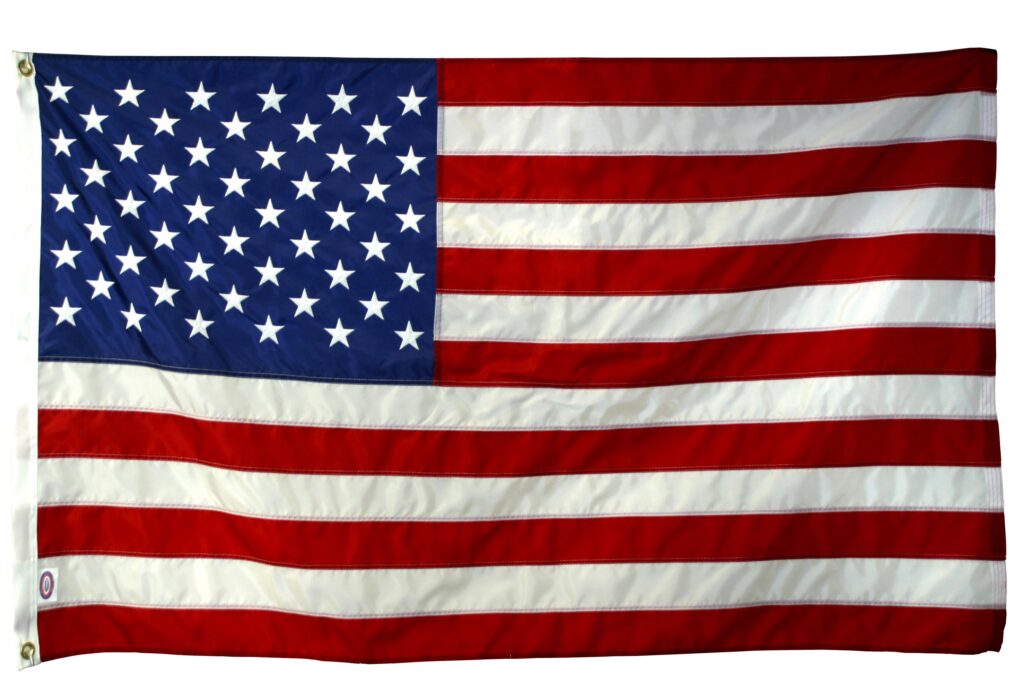
FROM WIKIPEDIA COMMONS
LYRICS
O say can you see, by the dawn’s early light,
What so proudly we hailed at the twilight’s last gleaming,
Whose broad stripes and bright stars through the perilous fight,
O’er the ramparts we watched, were so gallantly streaming?
And the rocket’s red glare, the bombs bursting in air,
Gave proof through the night that our flag was still there;
O say does that star-spangled banner yet wave
O’er the land of the free and the home of the brave?
On the shore dimly seen through the mists of the deep,
Where the foe’s haughty host in dread silence reposes,
What is that which the breeze, o’er the towering steep,
As it fitfully blows, half conceals, half discloses?
Now it catches the gleam of the morning’s first beam,
In full glory reflected now shines in the stream:
‘Tis the star-spangled banner, O long may it wave
O’er the land of the free and the home of the brave.
And where is that band who so vauntingly swore
That the havoc of war and the battle’s confusion,
A home and a country, should leave us no more?
Their blood has washed out their foul footsteps’ pollution.
No refuge could save the hireling and slave
From the terror of flight, or the gloom of the grave:
And the star-spangled banner in triumph doth wave,
O’er the land of the free and the home of the brave.
O thus be it ever, when freemen shall stand
Between their loved homes and the war’s desolation.
Blest with vict’ry and peace, may the Heav’n rescued land
Praise the Power that hath made and preserved us a nation!
Then conquer we must, when our cause it is just,
And this be our motto: ‘In God is our trust.’
And the star-spangled banner in triumph shall wave
O’er the land of the free and the home of the brave!
“The Star-Spangled Banner” is the national anthem of the United States. The lyrics come from the “Defence of Fort M’Henry“, a poem written on September 14, 1814, by 35-year-old lawyer and amateur poet Francis Scott Key after witnessing the bombardment of Fort McHenry by British ships of the Royal Navy in Baltimore Harbor during the Battle of Baltimore in the War of 1812. Key was inspired by the large U.S. flag, with 15 stars and 15 stripes, known as the Star-Spangled Banner, flying triumphantly above the fort during the U.S. victory.
The poem was set to the tune of a popular British song written by John Stafford Smith for the Anacreontic Society, a men’s social club in London. “To Anacreon in Heaven” (or “The Anacreontic Song”), with various lyrics, was already popular in the United States. This setting, renamed “The Star-Spangled Banner”, soon became a well-known U.S. patriotic song. With a range of 19 semitones, it is known for being very difficult to sing. Although the poem has four stanzas, only the first is commonly sung today.
“The Star-Spangled Banner” was recognized for official use by the United States Navy in 1889, and by U.S. president Woodrow Wilson in 1916, and was made the national anthem by a congressional resolution on March 3, 1931 (46 Stat. 1508, codified at 36 U.S.C. § 301), which was signed by President Herbert Hoover.
Before 1931, other songs served as the hymns of U.S. officialdom. “Hail, Columbia” served this purpose at official functions for most of the 19th century. “My Country, ‘Tis of Thee“, whose melody is identical to “God Save the Queen“, the United Kingdom’s national anthem, also served as a de facto national anthem. Following the War of 1812 and subsequent U.S. wars, other songs emerged to compete for popularity at public events, among them “America the Beautiful“, which itself was being considered before 1931 as a candidate to become the national anthem of the United States.
TODAY’S ALMANAC
Question of the Day
Why is it that wind makes a “whistling” noise as it blows “through” the windows when it is very cold outside, but it makes no sound when it is warm?It’s the wind speed that causes the whistling, not the temperature. Strong, even gale-force, winds are far more likely to occur during the winter, when it is cold. Warm weather usually brings gentler breezes—and open windows!
Advice of the Day
Well begun is half done.
Home Hint of the Day
Think twice about choosing aluminum siding if you live by the sea; corrosion is a problem in such areas.
Word of the Day
Semidiurnal TideA tide with one high water and one low water every half day. East Coast tides, for example, are semidiurnal, with two highs and two lows during a tidal day of approximately 24 hours.
Puzzle of the Day
What is the difference between a professor and a mosquito?One is a mentor, and the other is a torment.
Born
- George Mortimer Pullman (industrialist; designed luxury railroad cars) – 1831
- Alexander Graham Bell (inventor) – 1847
- Jean Harlow (actress) – 1911
- Arnold Newman (photographer) – 1918
- James Montgomery Doohan (actor, linguist) – 1920
- Perry Ellis (fashion designer) – 1940
- Miranda Richardson (actress) – 1958
- Herschel Walker (football player) – 1962
- Jackie Joyner-Kersee (heptathlon athlete; Olympic gold medalist) – 1962
- Jessica Biel (actress) – 1982
Died
- Lou Costello (actor & comedian) – 1959
- Danny Kaye (actor) – 1987
- Arthur Murray (dance teacher) – 1991
- Fred Friendly (documentary producer) – 1998
- Hank Ballard (singer and songwriter who wrote and recorded The Twist in 1958 which later was recorded by Chubby Checker) – 2003
- James Ludlow Elliot (astronomer who discovered the rings of Uranus) – 2011
Events
- First U.S. foreign aid bill authorized $50,000 for relief of victims of an earthquake in Venezuela– 1812
- Missouri Compromise was passed by U.S. Congress, admitting Maine as a free state and Missouri as a slave state– 1820
- Florida admitted to the Union as the 27th state– 1845
- Serfs were emancipated in Russia– 1861
- National Academy of Sciences signed into existence by Abraham Lincoln to advise the government on scientific and technical issues– 1863
- Carmen, by Georges Bizet, premiered in Paris– 1875
- First organized ice hockey match, Montreal, Canada– 1875
- Belva Ann Bennet Lockwood became first woman to try a case before the U.S. Supreme Court– 1879
- Anne Sullivan began teaching deaf/blind Helen Keller– 1887
- The U.S. Steel Corp. was formed– 1901
- Sing Sing prison in Ossining, New York, began taking prisoners’ fingerprints– 1903
- The National Advisory Committee for Aeronautics (NACA), the predecessor of NASA, was founded– 1915
- Treaty of Brest-Litovsk signed by Russia and the Central Powers– 1918
- First international airmail delivery was made from Vancouver, BC, to Seattle, WA– 1919
- The Star-Spangled Banner was officially designated U.S. national anthem– 1931
- First annual meeting of General Wildlife Federation (later, NWF), 1937.– 1937
- Puerto Rico became a U.S. commonwealth, with autonomy in internal affairs– 1952
- First fatal jetliner accident occured when a Canadian plane crashed in Karachi, Pakistan– 1953
- Pioneer 4, first U.S. spacecraft to orbit Sun, launched– 1959
- Apollo 9 spacecraft launched from Cape Kennedy– 1969
- Pierre Trudeau replaced Joe Clark as prime minister of Canada– 1980
- Steve Fossett became the first person to fly around the world solo without stopping or refueling, safely touching down in his custom-built plane 67 hours after taking off– 2005
- A 50-pound 6-ounce smallmouth buffalo fish was caught in Lake Fork, Texas– 2012
Weather
- Savannah, Georgia, received 10 inches of snow– 1837
- F5 “Candlestick Park” tornado struck Jackson, Mississippi– 1966
COURTESY www.almanac.com

I enjoy the efforts you have put in this, thank you for all the great blog posts.